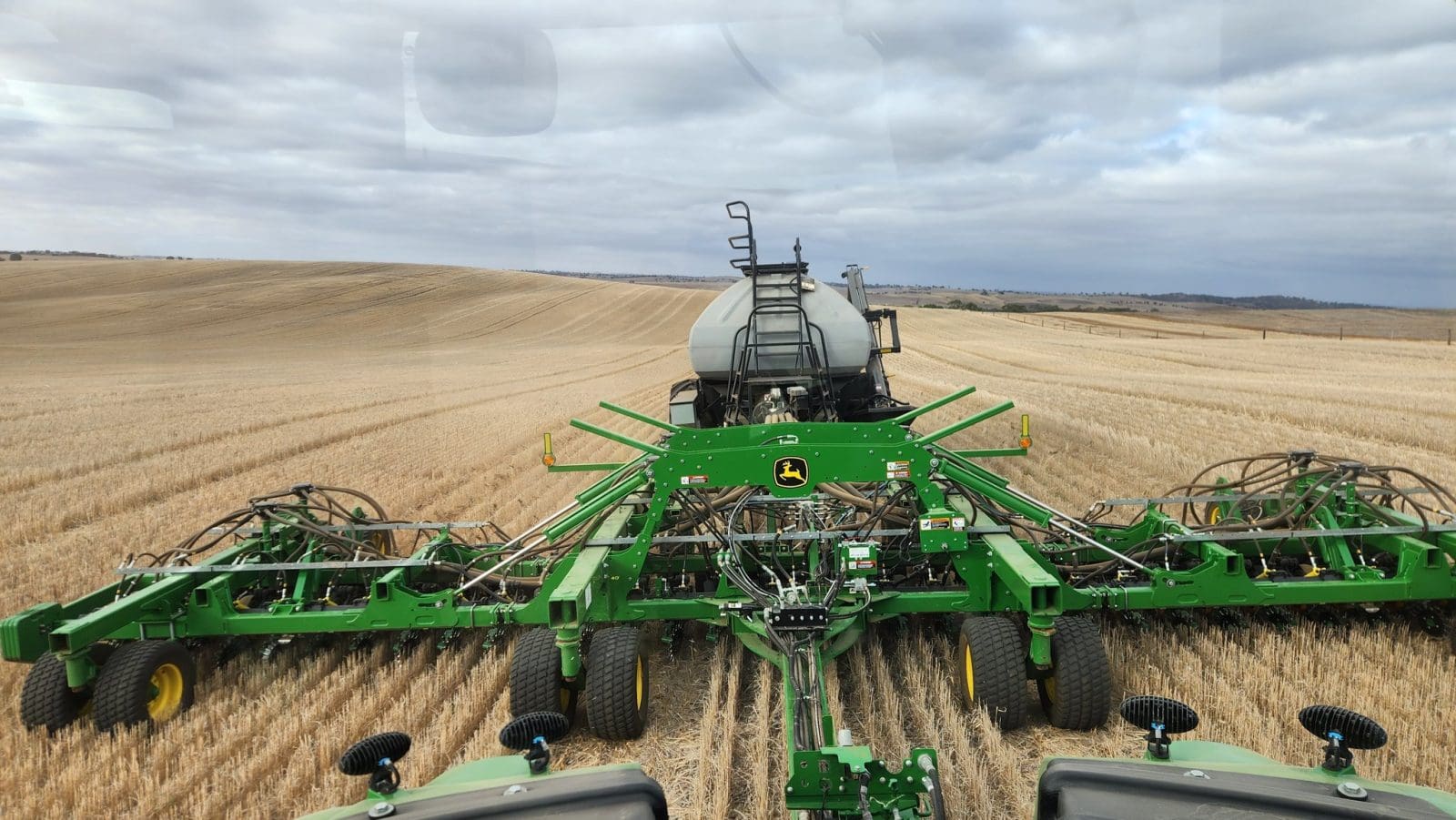
Dry seeding is under way on many SA farms as growers wait for the autumn break. Photo: Russell Zwar, Wirrabara
GROWERS across South Australia are dry sowing cereals, pulses, and canola and banking on a general rain in coming weeks to get the crop up and away.
While some regions received up to 10mm of rain over Easter, and a few pockets jagged more than 20mm, most of the state’s cropping regions have little to no subsoil moisture after what for many is the driest 18 months in living memory.
Last year’s drought saw SA produce its smallest winter crop since 2008-09 of 5.2 million tonnes (Mt), well down on the five-year average to 2023-24 of 9.1Mt.
A crop of 9Mt or more is seen as possible if all regions get at least 20mm in the next five weeks.
Victoria’s two main cropping regions, the Mallee and Wimmera, are in need of rain, although their subsoil moisture situation is generally better than SA’s, and some areas have had up to 20mm in the past month, enough to germinate dry-sown crops.
Southern New South Wales is also in need of general rain, but Queensland, central and northern NSW, and much of Western Australia are off to a flying start with their winter seeding programs.
Sticking to plan in Mid North
Platinum Ag Services agronomist Phil Holmes is based at Clare in SA’s Mid North, where Easter brought around 10mm to many growers.
“The highest I’ve heard was 28mm, and that was south of Riverton,” Mr Holmes said.
“There was very little seed in the ground at that point, mostly crops for stockfeed like vetch or barley, and also some oats for hay.
“Some places that got that rain would have crops poking through.”
Mr Holmes said many growers were sowing dry, with larger growers starting last month in order to get all area planted by early June, the end of the ideal planting window.
Forecasters including the Bureau of Meteorology do not have a rainfall event on their maps in coming weeks.
“What’s concerning for people… is the BoM is not talking about any significant rainfall in May, June or July.”
However, once maximum daytime temperatures drop below 23 degrees Celsius or so, a few millimetres of rain can go a long way, and successive showers rather than a widespread soak would get the crop up and away.
Mr Holmes said growers in the generally reliable and high-yielding Mid North planned to stick to their rotations, but may drop area or change crops planted once June rolls around.
“People in more marginal areas will probably not be sowing as much this year.”
Wirrabara grower Russell Zwar is halfway through dry sowing, with faba beans opening the planting program on April 21.
He plans to stick to his rotation plan for cereals and pulses, but is expecting to finish instead of start with canola, or perhaps hold canola over for next year if the break has not arrived by early June.
“Normally we’d sow canola first, but we’ll probably be sowing it last.”
EP growers up to half sown
On Eyre Peninsula, Agfert chief business growth and relations officer Tim Gurney said much of the fertiliser out-turn program from their new site at Cowell has finished as growers fill storages on their farms to complete sowing.
He said larger growers generally started planting in early April.
“Probably 50-60 percent of growers have started, and they’d be 30-50pc through,” Mr Gurney said.
He said other growers were waiting for a break to appear on the forecast before they start planting.
EP has a mix of continuous cropping and mixed farming, and Mr Gurney said fodder-crop area was likely to drop as soil temperatures fall to reduce the chances of establishing a good body of feed ahead of winter.
“If anything, lentils will continue to increase in rotation; they’re getting easier to grow.”
At Streaky Bay on EP’s west coast, Dion Trezona and family run Dohne sheep and grow wheat and barley as cash crops and oats for hay over 4000ha.
Last month, Mr Trezona planted oats which are yet to germinate, and more recently “scratched in” some vetch and field peas as a brown manure crop to provide groundcover and nitrogen to their sandy country.
“We’ll start seeding in the next three weeks; it takes 21-30 days to get the crop in, and we’ve got to have it finished by the June long weekend.”
The Trezona farm has an annual average rainfall of around 300mm, but got only 100mm last year which produced an average wheat and barley yield of 0.6t/ha, half its long-term average.
They have had less than 20mm of rain so far this year, and their ewe numbers are around half the norm due to the dry conditions.
Limited hay of concern
In the Mid North and in eastern SA, the recent SA Government drought package has enabled loads of donated hay to be delivered to mixed farmers and graziers.
Mr Holmes said there has been “a huge reduction” in livestock numbers in the region which started last spring.
“Some people have cut back their sheep numbers by a half, and some by 75pc, and some by only 20pc,” Mr Holmes said.
Hay is an important part of many Mid North cropping programs, and Mr Holmes said growers were being advised not to plant awnless winter wheat, which is better suited to a longer growing season.
Mr Holmes said canola had the highest gross margin of any of the region’s crops in 2024-25, and was therefore likely to stay in the rotation, despite the seed being relatively expensive, and its up-front nitrogen requirement being high.
“Because canola seems to be well suited to a dry season, growers will keep that in there, and lentils will stay in there because they don’t require nitrogen in crop.
“Oats has been swung towards heavily because there’s no hay around.”
Grain Central: Get our free news straight to your inbox – Click here

HAVE YOUR SAY